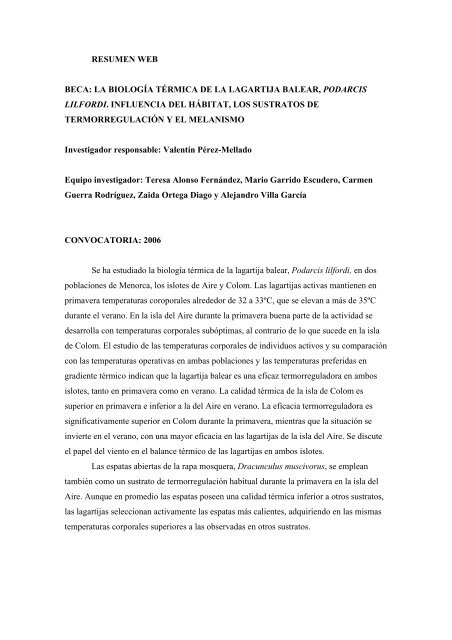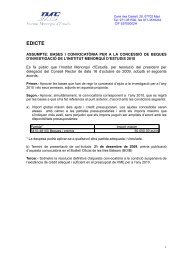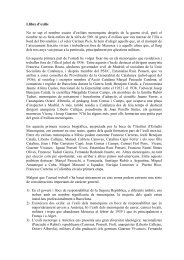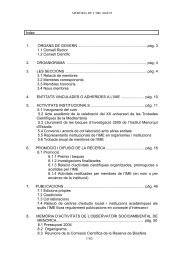resumen web beca: la biologÃa térmica de la lagartija balear ...
resumen web beca: la biologÃa térmica de la lagartija balear ...
resumen web beca: la biologÃa térmica de la lagartija balear ...
Create successful ePaper yourself
Turn your PDF publications into a flip-book with our unique Google optimized e-Paper software.
RESUMEN WEB<br />
BECA: LA BIOLOGÍA TÉRMICA DE LA LAGARTIJA BALEAR, PODARCIS<br />
LILFORDI. INFLUENCIA DEL HÁBITAT, LOS SUSTRATOS DE<br />
TERMORREGULACIÓN Y EL MELANISMO<br />
Investigador responsable: Valentín Pérez-Mel<strong>la</strong>do<br />
Equipo investigador: Teresa Alonso Fernán<strong>de</strong>z, Mario Garrido Escu<strong>de</strong>ro, Carmen<br />
Guerra Rodríguez, Zaida Ortega Diago y Alejandro Vil<strong>la</strong> García<br />
CONVOCATORIA: 2006<br />
Se ha estudiado <strong>la</strong> biología térmica <strong>de</strong> <strong>la</strong> <strong>la</strong>gartija <strong>balear</strong>, Podarcis lilfordi, en dos<br />
pob<strong>la</strong>ciones <strong>de</strong> Menorca, los islotes <strong>de</strong> Aire y Colom. Las <strong>la</strong>gartijas activas mantienen en<br />
primavera temperaturas coroporales alre<strong>de</strong>dor <strong>de</strong> 32 a 33ºC, que se elevan a más <strong>de</strong> 35ºC<br />
durante el verano. En <strong>la</strong> is<strong>la</strong> <strong>de</strong>l Aire durante <strong>la</strong> primavera buena parte <strong>de</strong> <strong>la</strong> actividad se<br />
<strong>de</strong>sarrol<strong>la</strong> con temperaturas corporales subóptimas, al contrario <strong>de</strong> lo que suce<strong>de</strong> en <strong>la</strong> is<strong>la</strong><br />
<strong>de</strong> Colom. El estudio <strong>de</strong> <strong>la</strong>s temperaturas corporales <strong>de</strong> individuos activos y su comparación<br />
con <strong>la</strong>s temperaturas operativas en ambas pob<strong>la</strong>ciones y <strong>la</strong>s temperaturas preferidas en<br />
gradiente térmico indican que <strong>la</strong> <strong>la</strong>gartija <strong>balear</strong> es una eficaz termorregu<strong>la</strong>dora en ambos<br />
islotes, tanto en primavera como en verano. La calidad térmica <strong>de</strong> <strong>la</strong> is<strong>la</strong> <strong>de</strong> Colom es<br />
superior en primavera e inferior a <strong>la</strong> <strong>de</strong>l Aire en verano. La eficacia termorregu<strong>la</strong>dora es<br />
significativamente superior en Colom durante <strong>la</strong> primavera, mientras que <strong>la</strong> situación se<br />
invierte en el verano, con una mayor eficacia en <strong>la</strong>s <strong>la</strong>gartijas <strong>de</strong> <strong>la</strong> is<strong>la</strong> <strong>de</strong>l Aire. Se discute<br />
el papel <strong>de</strong>l viento en el ba<strong>la</strong>nce térmico <strong>de</strong> <strong>la</strong>s <strong>la</strong>gartijas en ambos islotes.<br />
Las espatas abiertas <strong>de</strong> <strong>la</strong> rapa mosquera, Dracunculus muscivorus, se emplean<br />
también como un sustrato <strong>de</strong> termorregu<strong>la</strong>ción habitual durante <strong>la</strong> primavera en <strong>la</strong> is<strong>la</strong> <strong>de</strong>l<br />
Aire. Aunque en promedio <strong>la</strong>s espatas poseen una calidad térmica inferior a otros sustratos,<br />
<strong>la</strong>s <strong>la</strong>gartijas seleccionan activamente <strong>la</strong>s espatas más calientes, adquiriendo en <strong>la</strong>s mismas<br />
temperaturas corporales superiores a <strong>la</strong>s observadas en otros sustratos.
ABSTRACT<br />
The thermal biology of the Balearic lizard, Podarcis lilfordi was studied in two<br />
insu<strong>la</strong>r popu<strong>la</strong>tions of Menorca (Balearic Is<strong>la</strong>nds, Spain), Aire and Colom islets. Active<br />
lizards showed body temperatures around 32 to 33ºC during spring and above 35ºC during<br />
summer. In Aire islet, during spring, most of the activity was performed un<strong>de</strong>r suboptimal<br />
body temperatures, while the opposite situation was observed in Colom islet. The study of<br />
body temperatures in active lizards and the comparison with operative temperatures and the<br />
range of selected temperature range showed that the Balearic lizard is an efficient<br />
thermoregu<strong>la</strong>tor at both popu<strong>la</strong>tions and during both seasons un<strong>de</strong>r study. The thermal<br />
quality of Colom islet is higher during spring and lower during summer than the thermal<br />
quality of Aire islet. During spring, the effectiveness of temperature regu<strong>la</strong>tion is<br />
significantly higher in Colom islet, while during summer the situation is reverted, with a<br />
higher effectiveness in Aire islet. The role of wind in the thermal ba<strong>la</strong>nce of lizards at both<br />
islets was discussed.<br />
In Aire islet, during spring, the open spathes of the arum lily, Dracunculus<br />
muscivorus, were also employed as an usual thermoregu<strong>la</strong>tion perch. Even if the majority of<br />
the spathes had a lower thermal quality than other subtrates, lizards actively selected<br />
warmer spathes, reaching higher body temperatures than on other susbtrates.








